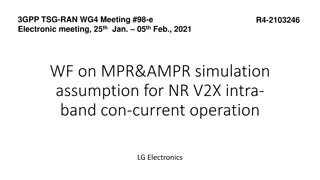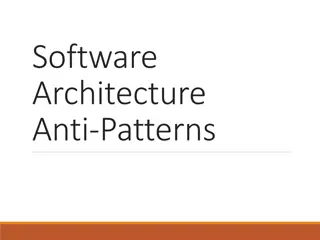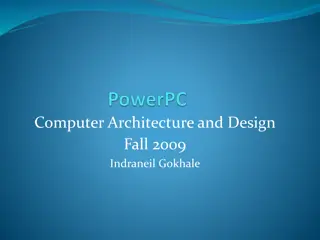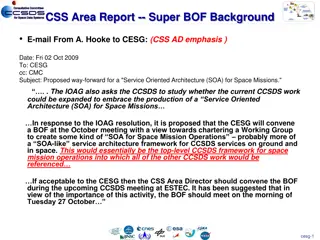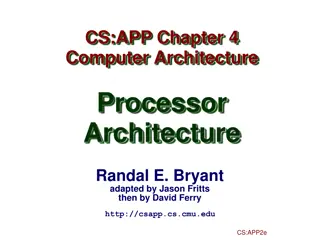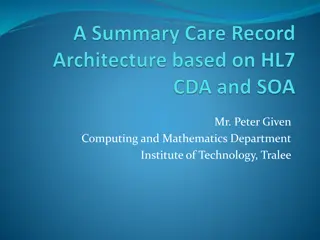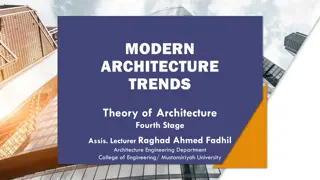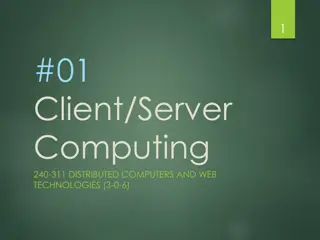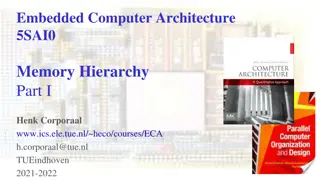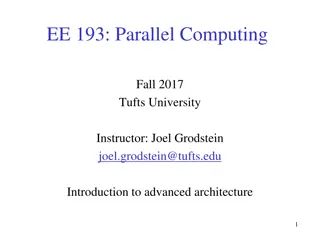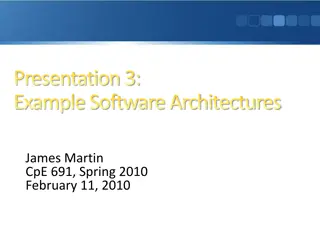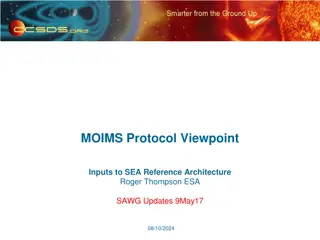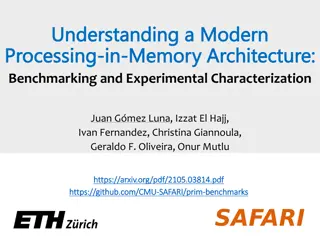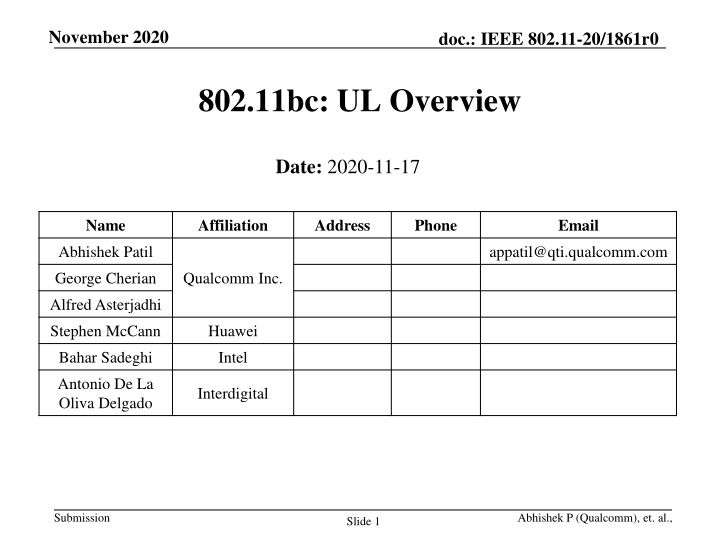
IEEE 802.11-20/1861r0 eBCS Uplink Architecture Overview
This presentation discusses the eBCS uplink architecture for joint telco with ARC, focusing on the UL scenario, operation, and key highlights. It elaborates on the roles of eBCS non-AP STA and AP in broadcasting UL eBCS frames, forwarding services, security parameters, and metadata embedding. The slides outline the actions taken by eBCS devices in transmitting frames to remote destinations with potential AP relationships and authentication measures. The content provides a detailed insight into the operation and structure of eBCS frames within the IEEE 802.11 standard.
Download Presentation

Please find below an Image/Link to download the presentation.
The content on the website is provided AS IS for your information and personal use only. It may not be sold, licensed, or shared on other websites without obtaining consent from the author. If you encounter any issues during the download, it is possible that the publisher has removed the file from their server.
You are allowed to download the files provided on this website for personal or commercial use, subject to the condition that they are used lawfully. All files are the property of their respective owners.
The content on the website is provided AS IS for your information and personal use only. It may not be sold, licensed, or shared on other websites without obtaining consent from the author.
E N D
Presentation Transcript
November 2020 doc.: IEEE 802.11-20/1861r0 802.11bc: UL Overview Date: 2020-11-17 Name Affiliation Address Phone Email Abhishek Patil appatil@qti.qualcomm.com George Cherian Qualcomm Inc. Alfred Asterjadhi Stephen McCann Huawei Bahar Sadeghi Intel Antonio De La Oliva Delgado Interdigital Submission Abhishek P (Qualcomm), et. al., Slide 1
November 2020 doc.: IEEE 802.11-20/1861r0 Abstract This presentation is a slide for joint telco with ARC to discuss the eBCS uplink architecture. Submission Slide 2 Abhishek P (Qualcomm), et. al.,
November 2020 doc.: IEEE 802.11-20/1861r0 eBCS UL Scenario An eBCS non-AP STA broadcasts UL eBCS (Mgmt) frame which includes: An eBCS AP that provides forwarding service: Forwarding service is best effort: URI to the remote destination A small payload carrying content from higher layer Optionally includes security parameters (certificate, timestamp and frame signature) Optionally includes a request to embed metadata Expected to be periodic in nature Forwards the higher layer content to the specified remote destination AP may perform source authentication or limit the amount/frequency of forwarding or embed metadata before forwarding. This can be based on an agreement with remote destination Non-AP STA may be unassociated with the forwarding AP Non-AP STA is not required to monitor the medium to discover APs that support forwarding It is possible that more than one AP in the neighborhood forwards the frame. Submission Slide 3 Abhishek P (Qualcomm), et. al.,
November 2020 doc.: IEEE 802.11-20/1861r0 eBCS UL Operation Key highlights Public Action frame broadcasted by an eBCS STA Self contained frame includes destination address, higher layer data, security parameters (optional) and request to embed metadata (optional) Forwarding AP extracts destination address and higher layer content creates an IP packet to be sent to the remote destination (out of scope of .11) Forwarding AP may have a relationship with remote server Authentication, throttling and format of metadata based on relationship with remote destination End-to-end authentication is out of scope of .11. Otherwise, assumes higher layer authentication and local throttling policies eBCS non- AP STA eBCS AP2 (w/o fwd) eBCS AP3 (w/ fwd) eBCS AP1 (w/ fwd) UL eBCS frame (broadcast) AP2 discards the frame Out of scope of .11 Remote Destination Submission Slide 4 Abhishek P (Qualcomm), et. al.,
November 2020 doc.: IEEE 802.11-20/1861r0 APPENDIX Submission Slide 5 Abhishek P (Qualcomm), et. al.,
November 2020 doc.: IEEE 802.11-20/1861r0 eBCS AP configuration Each forwarding AP sends an IP packet to the remote destination Possibility of a single IP packet directed to the remote destination when forwarding APs belong to the same ESS eBCS non-AP STA UL eBCS frame (broadcast) Remote Destination eBCS AP3 Controller AP2 discards the frame eBCS AP2 eBCS AP1 Submission Slide 6 Abhishek P (Qualcomm), et. al.,
July 2019 doc.: IEEE 802.11-19/0268r5 Use Case 10: AP tagged UL forwarding Topology/Architecture Stakeholders IoT Users, IoT operators, tracking services, etc MD tagID=123 Cloud server tagID=123 Airport 1 Manufactures of semiconductor, APs, networking and mobile devices tracker AP 1 No association Airport 2 Service scene An eBCS AP provides forwarding service to an end-servers for eBCS non-AP STAs that may not be associated with the AP MD tagID=123 tagID=123 tracker No AP 2 association APs append local location info before forwarding to the server MD tagID=123 Cloud server Airport 1 tagID=123 An eBCS AP appends on additional information before forwarding the packet to the addressed server tracker No AP 1 association tagID=123 association No MD tagID=123 Blind broadcast multiple APs may forward w/o association AP 2 Required function Pre-configured low-cost low power tracker device automatically connects to an end server through eBCS APs in the neighborhood with zero setup action Tracker device periodically reports to its server through eBCS APs without scanning and association eBCS AP appends metadata (such as IP, date/time, location, RSSI etc) to the packets before forwarding to the destination server Meta-data from an eBCS AP will be protected Expected benefits: Ability to broadcast information destined to the end server Ability to reduce cost and implementation complexity Ability to enable low power STA operations Xiaofei WANG (InterDigital) Submission Slide 7
July 2019 doc.: IEEE 802.11-19/0268r5 OCB for UL Data In the early days of the project, TGbc discussed OCB as an option for UL forward use case and decided to not pursue it Primary reasons being: OCB doesn t have the concept of infra-BSS As a result, a forwarding eBCS AP would need to implement at least two interfaces One to support eBCS AP operation Another to operate as an eBCS STA Submission Slide 8 Xiaofei Wang (InterDigital)
July 2019 doc.: IEEE 802.11-19/0268r5 UL eBCS frame format Submission Slide 9 Xiaofei Wang (InterDigital)



